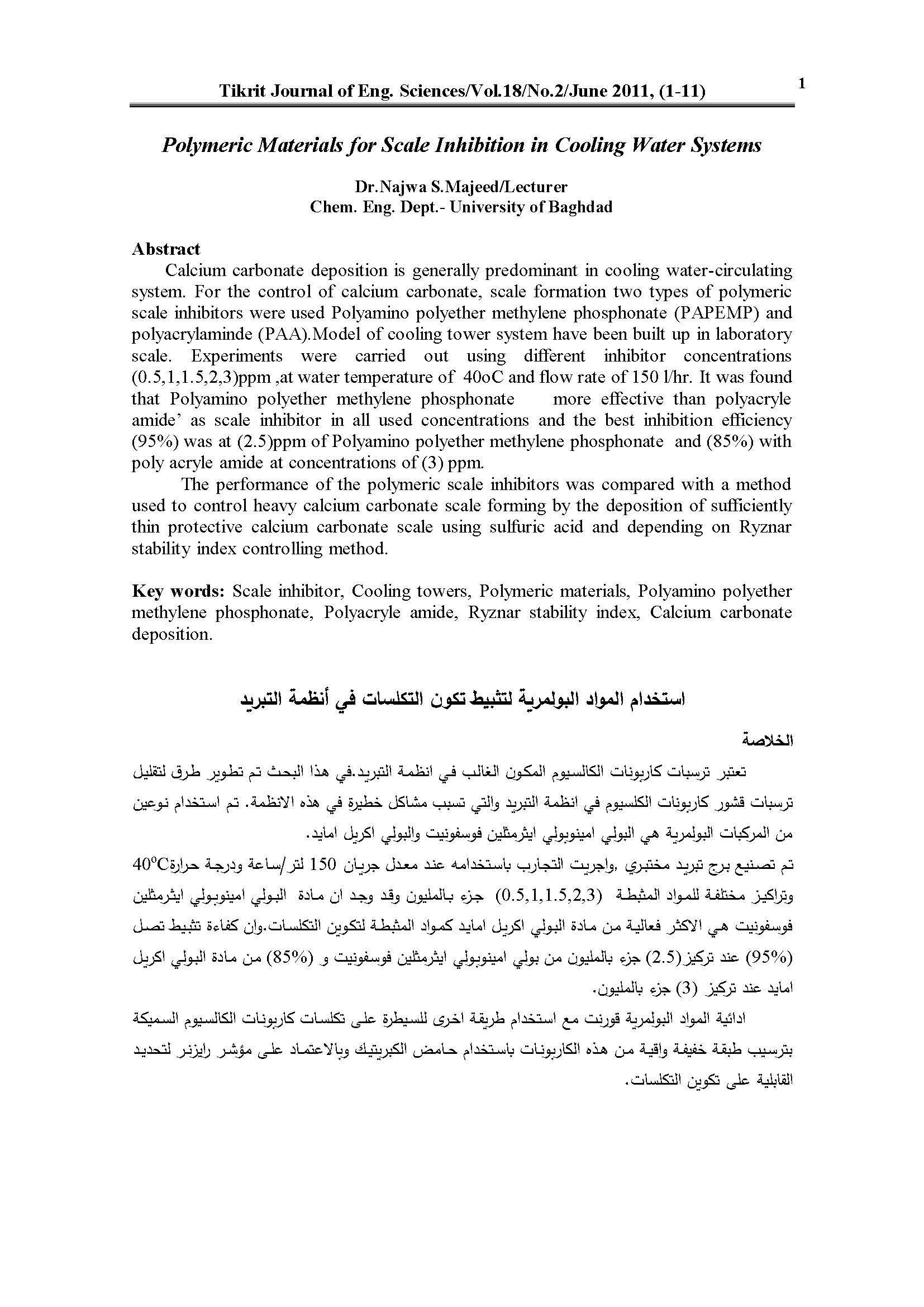Polymeric Materials for Scale Inhibition in Cooling Water Systems
Main Article Content
Abstract
Calcium carbonate deposition is generally predominant in cooling water-circulating system. For the control of calcium carbonate, scale formation two types of polymeric scale inhibitors were used Polyamino polyether methylene phosphonate (PAPEMP) and polyacrylaminde (PAA).Model of cooling tower system have been built up in laboratory scale. Experiments were carried out using different inhibitor concentrations (0.5, 1, 1.5, 2, 3) ppm, at water temperature of 40oC and flow rate of 150 l/hr. It was found that Polyamino polyether methylene phosphonate more effective than polyacryle amide’ as scale inhibitor in all used concentrations and the best inhibition efficiency (95%) was at (2.5) ppm of Polyamino polyether methylene phosphonate and (85%) with polyacryle amide at concentrations of (3) ppm.
The performance of the polymeric scale inhibitors was compared with a method used to control heavy calcium carbonate scale forming by the deposition of sufficiently thin protective calcium carbonate scale using sulfuric acid and depending on Ryznar stability index controlling method.
Article Details
Section

This work is licensed under a Creative Commons Attribution 4.0 International License.
THIS IS AN OPEN ACCESS ARTICLE UNDER THE CC BY LICENSE http://creativecommons.org/licenses/by/4.0/
References
M. Zubair, A. K. Sheikh, M. U. Haq “CaCO3 Fouling in AlSl 316 stainless tubes” The fourth engineering conference. Nov. (1995) volume (IV).
Zahid Amjad, and Robert W. Zuhl,”The use of polymers to improve control of calcium phosphonate and Calcium carbonate in high stressed cooling water systems “Association of water technologies, Inc. November (2004) (Internet document).
Chen Wang, Shu-pingli, Tion-duoli “Calcium carbonate inhibition by a phosphonate terminated poly (maleic-co-sulfonate) polymeric inhibitor, Desalination, 249 (2009) (1-4).
Teresa Szymura, “Deposits in water based cooling systems” physiochemical problems of Mineral processing, 42 (2008) , (131-140).
Amjed Z.,PUGH ,Zibida J, Polymer performance in cooling water; The Influence of process variables, chemical treatment materials Performances, 1, 32 -28 (1997).
Deposition text-(internet www.gc3 / techdb / manual / depext.htm.
Handbook, “Water purification handbook “Chapter 25 Deposition and scale control – cooling system (Internet document) 2009.
J. S. Gill and M. Lo Re, “The effect of polyamino polyether phosphonate on the crystallization kinetics of Calcium carbonate” NACE paper No. 157 (1996).
J. S. Gill, M. A. Yorke, S. L Hollinshad, proceeding of International water conference, IWC – 94 – 60 (1994).
Zahid A., Jeff P., Robert W. Zuhl “Polymer performance in cooling water: The influence of process variables” Paper No.160 Corrosion /96 (NACE International 1996)
Sheppard T. Powell “water conditioning for industry “Mc Graw – Hill Book company, Inc, New York, Toranto, Landon (1954).
Powell S.T., H, E. Bacon, and J. R. Hill “Corrosion prevention by controlled calcium carbonate scale”.Ind.Eng.Chem.,37,845(1945.
Langelier, W. F. “The Analytic control of Anti – corrosion water treatment”, JAWWA, 28; 1500 (1936).
Ryznar, J. W. “A New Index for determining amount of calcium carbonate scale by a water”, JAWWA, vol. 36 (1944).
Jack C. Cowan and Donald J. Weintritt “Water –Formed Scale deposits” Gulf publishing (1976).
Haenisch D. Sawyer, Pierce E. L “Quantitative Analysis”, 4th Ed (1958).





